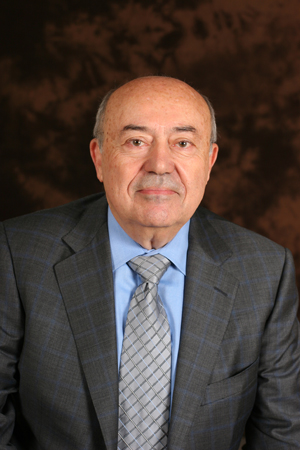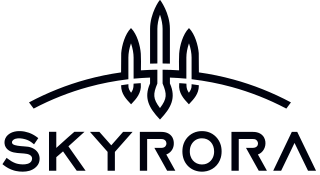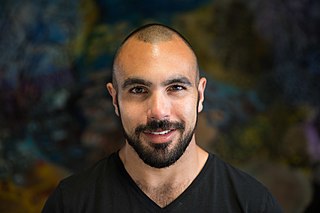Related Research Articles

The USC Information Sciences Institute (ISI) is a component of the University of Southern California (USC) Viterbi School of Engineering, and specializes in research and development in information processing, computing, and communications technologies. It is located in Marina del Rey, California.

Andrew James Viterbi is an Italian Jewish–American electrical engineer and businessman who co-founded Qualcomm Inc. and invented the Viterbi algorithm. He is the Presidential Chair Professor of Electrical Engineering at the University of Southern California's Viterbi School of Engineering, which was named in his honor in 2004 in recognition of his $52 million gift.

William Daniel Hillis is an American inventor, entrepreneur, and computer scientist, who pioneered parallel computers and their use in artificial intelligence. He founded Thinking Machines Corporation, a parallel supercomputer manufacturer, and subsequently was Vice President of Research and Disney Fellow at Walt Disney Imagineering.

The USC Viterbi School of Engineering is the engineering school of the University of Southern California. It was renamed following a $52 million donation by Andrew J. Viterbi, co-founder of Qualcomm.
Contour crafting is a building printing technology being researched by Behrokh Khoshnevis of the University of Southern California's Information Sciences Institute that uses a computer-controlled crane or gantry to build edifices rapidly and efficiently with substantially less manual labor. It was originally conceived as a method to construct molds for industrial parts. Khoshnevis decided to adapt the technology for rapid home construction as a way to rebuild after natural disasters, like the devastating earthquakes that have plagued his native Iran.

Gwynne Shotwell is an American businesswoman and engineer. She is the president and chief operating officer of SpaceX, an American space transportation company, where she is responsible for day-to-day operations and company growth.
3D printing began to be used in production versions of spaceflight hardware in early 2014, when SpaceX first flew a flight-critical propulsion system assembly on an operational Falcon 9 flight. A number of other 3D-printed spacecraft assemblies have been ground-tested, including high-temperature, high-pressure rocket engine combustion chambers and the entire mechanical spaceframe and integral propellant tanks for a small satellite.

Electron is a two-stage, partially reusable orbital launch vehicle developed by Rocket Lab, an American aerospace company with a wholly owned New Zealand subsidiary. Electron was developed to service the commercial small satellite launch market. As of May 2024, it’s the third most launched small-lift launch vehicle in history. Its Rutherford engines are the first electric-pump-fed engine to power an orbital-class rocket. Electron is often flown with a kickstage or Rocket Lab's Photon spacecraft. Although the rocket was designed to be expendable, Rocket Lab has recovered the first stage twice and is working towards the capability of reusing the booster. The Flight 26 (F26) booster has featured the first helicopter catch recovery attempt.

A small-lift launch vehicle is a rocket orbital launch vehicle that is capable of lifting 2,000 kg (4,400 lb) or less or under 5,000 kilograms (11,000 lb) of payload into low Earth orbit (LEO). The next larger category consists of medium-lift launch vehicles.
Vector Launch, Inc. is an American space technology company which aims to launch suborbital and orbital payloads. Vector Launch declared bankruptcy in December 2019 and re-emerged in October 2020.
Relativity Space Inc. is an American aerospace manufacturing company headquartered in Long Beach, California. Relativity Space is developing manufacturing technologies, launch vehicles, and rocket engines for commercial orbital launch services. The company is notable for manufacturing most of their Terran 1 and Terran R rocket parts using 3D printing. As of April 2024, Terran R is on track for initial launch in 2026.

Greg Autry is an American space policy expert, educator, entrepreneur and author. He is the Clinical Professor (FSC) and Director of the Thunderbird Initiative for Space Leadership, Policy, and Business at the Thunderbird School of Global Management at Arizona State University. He previously served as Chair of the Safety Working Group on the COMSTAC; his two-year tenure ended in 2022. He was an assistant professor of Clinical Entrepreneurship in Marshall School of Business at the University of Southern California. Prior to that, he served as an adjunct professor of strategy and entrepreneurship at the Merage School of Business at the University of California, Irvine. Autry served on the NASA Agency Review Team for the incoming Trump administration in 2016 and temporarily as the White House Liaison at NASA in 2017. He holds an MBA and PhD from the University of California, Irvine.

Skyrora Ltd is a British private space company based in Edinburgh, Scotland, since 2017.

This article documents expected notable spaceflight events during the year 2026.
Mahta Moghaddam is an Iranian-American electrical and computer engineer and William M. Hogue Professor of Electrical Engineering in the Ming Hsieh Department of Electrical and Computer Engineering at the University of Southern California Viterbi School of Engineering. Moghaddam is also the president of the IEEE Antennas and Propagation Society and is known for developing sensor systems and algorithms for high-resolution characterization of the environment to quantify the effects of climate change. She also has developed innovative tools using microwave technology to visualize biological structures and target them in real-time with high-power focused microwave ablation.

Jordan Noone is an American aerospace engineer and the Founding CTO of Relativity Space. He is now a General Partner at Embedded Ventures which he co-founded in 2020 with Jenna Bryant.
Terran R is a heavy-lift two-stage, partially reusable launch vehicle under development by Relativity Space. The vehicle is partially constructed with 3D printing technologies, like its predecessor, the small-lift Terran 1. The first flight is expected to be in 2026.
Terran 1 was an expendable two-stage small-lift launch vehicle developed by Relativity Space. Development began in 2017 and the rocket was retired in 2023. Most structures and components of the vehicle are manufactured with 3D printing processes.
Andrea P. Belz is an American innovation engineer, academic and author. She is a Professor of Practice in Industrial and Systems Engineering and the Vice Dean of Transformative Initiatives in the Viterbi School of Engineering at the University of Southern California (USC).
References
- ↑ "Reopening the American Frontier: Promoting Partnerships Between Commercial Space and the U.S Government to Advance Exploration and Settlement" (PDF). NASA. July 13, 2017. Archived (PDF) from the original on August 24, 2020. Retrieved August 14, 2020.
- 1 2 3 Masunaga, Samantha (April 27, 2018). "Entrepreneur seeks to boldly go where no one has gone before: 3-D printing nearly an entire rocket". Los Angeles Times. Archived from the original on October 12, 2018. Retrieved August 10, 2020.
- 1 2 Ignacio, Guttierez (August 23, 2019). "We're Going to 3-D Print the First Rocket Made on Mars". USC Viterbi School of Engineering. Archived from the original on August 24, 2020. Retrieved August 14, 2020.
- ↑ Autry, Greg (March 26, 2020). "Relativity: Spaceflight Imprinted With Flexibility". Forbes. Archived from the original on March 27, 2020. Retrieved August 14, 2020.
- 1 2 3 4 5 Tzinis, Irene (June 12, 2020). "Mr. Tim Ellis". NASA. Archived from the original on August 24, 2020. Retrieved August 11, 2020.
- 1 2 Ryan, Kevin (April 30, 2018). "Life on Mars Looks a Little More Possible Thanks to This Startup's 3-D Printed Rocket". Inc. Archived from the original on July 29, 2020. Retrieved August 10, 2020.
- ↑ Billings, Lee (April 16, 2018). "Q&A: 3-D Printing Rockets with Relativity Space CEO Tim Ellis". Scientific American. Archived from the original on April 5, 2019. Retrieved August 10, 2020.
- ↑ Perez, Denrie Caila (April 29, 2020). "Relativity Space to Launch First 3D-Printed Rocket". Engineering.com. Archived from the original on June 17, 2020. Retrieved August 19, 2020.
- ↑ Clifford, Catherine (January 25, 2018). "These guys cold-emailed Mark Cuban and got a half-million-dollar investment in their start-up". CNBC. Archived from the original on August 9, 2020. Retrieved August 10, 2020.
- ↑ Berger, Eric (October 1, 2019). "Amid heavy competition, Relativity Space secures $140 million in funding". Ars Technica. Archived from the original on December 29, 2019. Retrieved August 24, 2020.
- ↑ Sheetz, Michael (June 8, 2021). "Relativity Space raises $650 million from Fidelity and others to build 3D-printed SpaceX competitor". CNBC. Retrieved July 7, 2021.
- ↑ "Meet the 2019 TIME 100 Next". Time. Archived from the original on November 27, 2019. Retrieved August 19, 2020.
- ↑ Virts, Terry. "TIME Next 100: Tim Ellis". TIME. Archived from the original on April 13, 2020. Retrieved August 19, 2020.
- ↑ "Innovators Under 35 2019". MIT Technology Review. Archived from the original on August 24, 2020. Retrieved August 19, 2020.
- ↑ "30 Under 30 2019: Manufacturing & Industry". Forbes. Archived from the original on August 9, 2020. Retrieved August 19, 2020.
- ↑ "30 Under 30 2019: Big Money". Forbes. Archived from the original on November 27, 2019. Retrieved August 19, 2020.
- ↑ Holmes, Mark; Hill, Jeffery (March 2020). "The Nominees for 2019 Satellite Executive of the Year". Via Satellite. Archived from the original on April 18, 2020. Retrieved August 19, 2020.
- ↑ "Meet the 30 Most Inspiring Young Entrepreneurs of 2018". Inc.com. Archived from the original on April 19, 2019. Retrieved August 19, 2020.